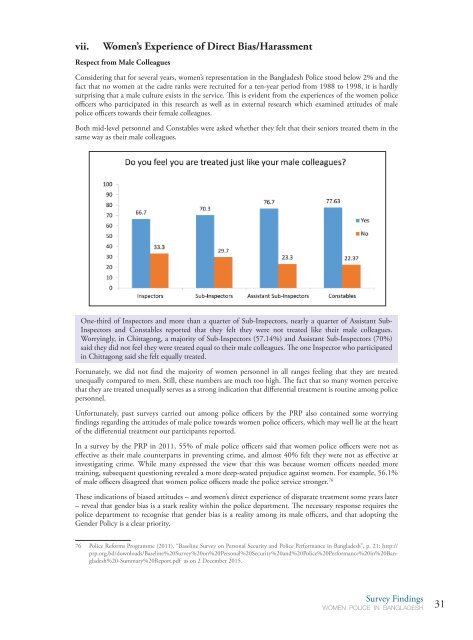ROUGH ROADS TO EQUALITY
22SDTw
22SDTw
You also want an ePaper? Increase the reach of your titles
YUMPU automatically turns print PDFs into web optimized ePapers that Google loves.
vii.<br />
Women’s Experience of Direct Bias/Harassment<br />
Respect from Male Colleagues<br />
Considering that for several years, women’s representation in the Bangladesh Police stood below 2% and the<br />
fact that no women at the cadre ranks were recruited for a ten-year period from 1988 to 1998, it is hardly<br />
surprising that a male culture exists in the service. This is evident from the experiences of the women police<br />
officers who participated in this research as well as in external research which examined attitudes of male<br />
police officers towards their female colleagues.<br />
Both mid-level personnel and Constables were asked whether they felt that their seniors treated them in the<br />
same way as their male colleagues.<br />
One-third of Inspectors and more than a quarter of Sub-Inspectors, nearly a quarter of Assistant Sub-<br />
Inspectors and Constables reported that they felt they were not treated like their male colleagues.<br />
Worryingly, in Chittagong, a majority of Sub-Inspectors (57.14%) and Assistant Sub-Inspectors (70%)<br />
said they did not feel they were treated equal to their male colleagues. The one Inspector who participated<br />
in Chittagong said she felt equally treated.<br />
Fortunately, we did not find the majority of women personnel in all ranges feeling that they are treated<br />
unequally compared to men. Still, these numbers are much too high. The fact that so many women perceive<br />
that they are treated unequally serves as a strong indication that differential treatment is routine among police<br />
personnel.<br />
Unfortunately, past surveys carried out among police officers by the PRP also contained some worrying<br />
findings regarding the attitudes of male police towards women police officers, which may well lie at the heart<br />
of the differential treatment our participants reported.<br />
In a survey by the PRP in 2011, 55% of male police officers said that women police officers were not as<br />
effective as their male counterparts in preventing crime, and almost 40% felt they were not as effective at<br />
investigating crime. While many expressed the view that this was because women officers needed more<br />
training, subsequent questioning revealed a more deep-seated prejudice against women. For example, 56.1%<br />
of male officers disagreed that women police officers made the police service stronger. 76<br />
These indications of biased attitudes – and women’s direct experience of disparate treatment some years later<br />
– reveal that gender bias is a stark reality within the police department. The necessary response requires the<br />
police department to recognise that gender bias is a reality among its male officers, and that adopting the<br />
Gender Policy is a clear priority.<br />
76 Police Reforms Programme (2011), “Baseline Survey on Personal Security and Police Performance in Bangladesh”, p. 21: http://<br />
prp.org.bd/downloads/Baseline%20Survey%20on%20Personal%20Security%20and%20Police%20Performance%20in%20Bangladesh%20-Summary%20Report.pdf<br />
as on 2 December 2015.<br />
Survey Findings<br />
WOMEN POLICE IN BANGLADESH<br />
31<br />
Rough Road to Equality_Bangladesh Police_7-12-15.indd 37<br />
1/8/2016 5:00:43 PM


